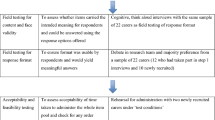Abstract
A semi-structured interview was conducted with dementia patients and their caregivers in order to explore which aspects of quality of life were perceived as relevant and important. These aspects of quality of life were compared with the content of three generic utility-based quality of life instruments: European Quality of Life Instrument, Health Utilities Index, and Quality of Well-Being (QWB) Scale. Twenty patients with mild dementia and 20 caregiver volunteers provided narrative data derived from interviews that were analyzed using a modified Grounded Theory method of analysis. Essential attributes of dementia quality of life identified by the respondents were missing in the three utility-based quality of life instruments selected for the study. Patients provided a wider range of attributes than the instruments including some attributes not described by caregivers. Of the three utility-based measures, the QWB scale included the largest number of quality of life attributes but still missed many. Compared to the respondent generated attributes all three utility-based quality of life instruments have important shortcomings in content validity.
Similar content being viewed by others
References
Gauthier S, Thal LJ, Rossor M. The future diagnosis and treatment of Alzheimer's Disease. In: Gauthier S (ed.), Clinical Diagnosis and Treatment of Alzheimer's disease, London: Martin Dunitz, 1996.
Evans DA, Funkelstein HH, Albert MS, et al. Prevalence of Alzheimer's disease in a community population of older persons: Higher than previously reported. JAMA 1989; 262: 2551–2556.
Evans DA. Estimated prevalence of Alzheimer's disease in the US. Milbank Q 1990; 68: 267–289.
DeJong R, Osterlund OW, Roy GW. Measurement of quality of-life changes in patients with Alzheimer's disease. Clin Ther 1989; 11(4): 545–554.
Grut M, Jorm AF, Fratiglioni L, Forsell Y, Viitanen M, Winblad B. Memory complaintsof elderly people in a population survey: Variation according to dementia stage and depression. J Am Geriatr Soc 1993; 41(12): 1295–1300.
David P. Effectiveness of group work with the cognitive impaired older adult. Am J Alzheimers Care and Relat Disord Res 1991; 10–16.
Foley J. The experience of being demented. In: Binstock R, Post S, Whitehouse P (eds), Dementia and Aging, Baltimore: John Hopkins University Press, 1992.
Parse RR. Quality of life for persons living with Alzheimer's disease: The human becoming perspective. Nurs Sci Q 1996; 9(3): 126–133.
Burgener SC, Dickerson-Putman J. Assessing patients in the early stages of irreversible dementia. The relevance of patient perspectives. J Gerontol Nurs 1999; 25(2): 33–41.
Acton GJ, Mayhew PA, Hopkins BA, Yauk S. Communicating with individualswith dementia. The impaired person's perspective. J Gerontol Nurs 1999; 25(2): 6–13.
Selai C. Using the EuroQol EQ-5D in dementia. In: Proceedings of the EuroQol Plenary Meeting, Rabin RE, Busschbach J, De Charro F, Essink-Bot M (eds), Rotterdam: Erasmus University. Referenced in: Selai C, Trimble R. Assessing quality of life in dementia. Aging Mental Health 1998; 3(2): 108.
Neumann PJ, Kuntz KM, Leon J, Araki SS, Hermann RC, Hsu MA, Weinstein MC. Health utilities in Alzheimer's disease: A cross-sectional study of patients and caregivers. Med Care 1999; 37(1): 27–32.
Kerner DN, Patterson TL, Grant I, Kaplan RM. Validity of the Quality of Well-Being Scale for patientswith Alzheimer's disease. J Aging Health 1998; 10(1): 44–61.
Gold MR, Patrick DL, Torrance GW, Fryback DG, Hadorn DC, Kamlet MS, Daniels N, Weinstein MC. Identifying and valuing outcomes. In: Gold MR et al. (eds), Cost-Effectiveness in Health and Medicine, New York: Oxford University Press, 1996, pp. 109–110.
Krahn M, Mahoney J, Trachtenberg J, Eckman M, Pauker S, Detsky AS. Screening for Prostate Cancer: A Decison Analytic View. JAMA 1994; 272: 773–780.
Bennett KJ, Torrance GW, Goldsmith CH, Tugwell P. Methodologic challengesin the development of utility measures of health related quality of life in rheumatoid arthritis. Control Clin Trials 1991; 12(suppl): 118s-128s.
Bennett JK, Torrance GW, Moran LA, Smith F, Goldsmith CH. Health State Utilities in Knee Replacement Surgery: The development and validation of McKnee. J Rheumatol 1997; 24: 1796–1805.
Krahn M, Ritvo P, Irvine J, et al. Construction of the Patient-Oriented Prostate Utility Scale (PORPUS): A multi-attribute health state classification system for prostate cancer. J Clin Epidemiol 2000; 53: 920–930.
Hodder SC, Edwards MJ, Brickley MR, Shepherd JP. Multiattribute utility assessment of outcomes of treatment for head and neck cancer. Br J Can 1997; 75: 898–902.
Bennett KJ, Torrance GW, Boyle BH, Guscott R, Moran LA. Development and testing of a utility measure for major, unipolar depression (McSad). Qual Life Res 2000; 9(1): 109–120.
Revicki DA, Leidy NK, Brennan-Diemer F, Thompson C, Togias A. Development and preliminary validation of the multiattribute RhinitisSymptom Utility Index. Qual Life Res 1998; 78(8): 693–702.
Froberg DG, Kane RL. Methodology for measuring health-state preferences-II: Scaling methods. J Clin Epidemiol 1989; 42(5): 459–471.
Glaser B, Strauss A. The Discovery of Grounded Theory: Strategiesfor qualitative research. Chicago: Aldine, 1967.
Lincoln Y, Guba E. Naturalistic Inquiry. Newbury Park California: Sage, 1995. Publications.
Logsdon RG, Gibbons LE, McCurry SM, Teri L. Quality of life in Alzheimer's disease: Patient and caregiver reports. J Mental Health Aging 1999; 5: 21–32.
Brod M, Stewart AL, Sands L, Walton P. Conceptualization and measurement of quality of life in dementia: The dementia quality of life instrument (DQoL). The Gerontologist 1999; 39(1): 25–35.
Author information
Authors and Affiliations
Corresponding author
Rights and permissions
About this article
Cite this article
Silberfeld, M., Rueda, S., Krahn, M. et al. Content validity for dementia of three generic preference based health related quality of life instruments. Qual Life Res 11, 71–79 (2002). https://doi.org/10.1023/A:1014406429385
Issue Date:
DOI: https://doi.org/10.1023/A:1014406429385




